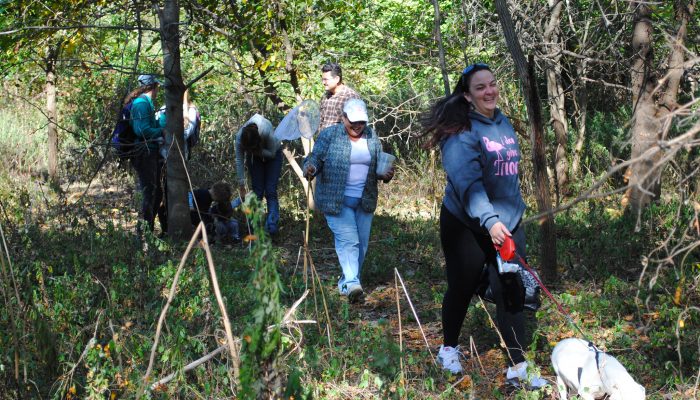By Christina N. Moresi, M.Ed., Environmental Education Planner, Wissahickon Environmental Center (Tree House)
As environmental educators, we often discuss with our adult and youth visitors the importance of outdoor play, and the dangers of tick bites. The comfort level of our visitors ranges from anxious or scared to comfortable and connected, but one concern that they have in common is ticks and Lyme disease. This is a valid concern that must be taken seriously, but one that should never stop you from spending time outdoors.
Ticks are arachnids (eight-legs) that eat blood to survive. When we speak specially about “Lyme disease ticks” or “deer ticks,” we are referring to the black legged-tick. These are extremely tiny ticks that are not always as noticeable on skin or clothes as the dog tick.
There are basic precautions that everyone should take anytime they are outdoors, front yard or forest and everywhere in between.
- Repellent: Spray repellent on exposed skin and clothes. DEET-based repellents at concentrations of >20% or higher are the most effective at preventing tick bites and safe for use. Several other effective repellent options are available, including picaridin and oil of lemon eucalyptus. The EPA has introduced a tool to help you find the repellent that is right for you. Whatever repellent you choose, always read and follow the application instructions on the product label before use.
- Clothing: Wear light-colored clothing so that you can see if a tick on you, and consider treating clothes with permethrin when working or hiking outdoors.
- “Tick check every day after play.”: Before leaving an outdoor area, and again before going inside, shake out and bush down your hair, hat, clothes, etc. from head to toe. Tumble dry clothes and gear in a dryer on high heat for 10 minutes to kill any black-legged ticks. If you find a tick attached to you, follow these steps for safe and effective tick removal.
- Bathe and check again: Wash thoroughly as soon as possible, and check your dark and personal places for any raised black dot.
- Check your pets for ticks: Also talk to your veterinarian about tick prevention, especially if your pets will be outside.
- Lawn maintenance: Keep ticks away in your own backyard through regular lawn care, including keeping grass short and removing brush where ticks like to hide.
These steps may seem like a lot, but they are quick once they become routine, and will significantly reduce the chance a tick attaching to you and possibly transmitting Lyme.
Some other things to keep in mind about Lyme:
- Not all ticks are infected with the Lyme bacteria, and those that are can take 24 hours or more to transmit the disease while feeding. So while it is more important to be aware of the symptoms, early testing following a found tick can result in a false negative, or induce unnecessary worry.
- Symptoms of early Lyme disease may present as a flu-like illness and include symptoms such as fever, chills, sweats, muscle aches, fatigue, nausea, and joint pain.
- The Erythema migrans (EM) rash, or “bull’s eye” rash, may actually be any shape rash, anywhere on the body (not just the bite site), or it may not appear at all.
- Self-advocacy is key to diagnosing Lyme early and receiving quick, proper treatment. The later stages of Lyme are more difficult to treat, and some symptoms can persist following treatment. If you think you have Lyme, speak with our doctor about your exposures and symptoms.
- Do not forget to tick check every day after play.




